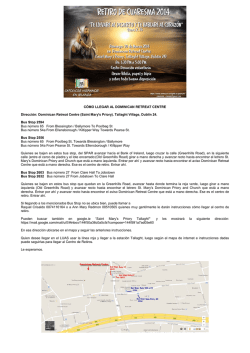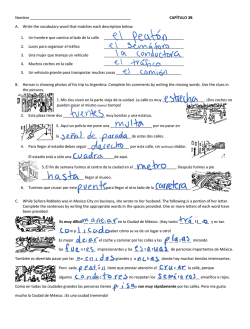
¿Cómo voy a…? Español 2 – UNIDAD 5 NOMBRE
¿Cómo voy a…? Español 2 – UNIDAD 5 A. PARTS OF THE CITY avenue block bridge corner fountain highway intersection monument neighborhood plaza (central area) statue stop light stop sign street traffic circle Los partes de la ciudad la avenida la cuadra el puente la esquina la fuente la carretera el cruce el monumento el barrio / vecindario la plaza la estatua el semáforo la señal de parada la calle la rotonda / glorieta C. GIVING DIRECTIONS behind beside close to far from from/since in front of in the middle more or less slow straight straight ahead to the left to the right to be careful to continue to cross to hurry to pass / go to stop to turn towards until Para dar las dirreciones detrás de al lado de cerca de lejos de desde enfrente de en el medio de más o menos despacio derecho todo derecho a la izquierda a la derecha tener cuidado seguir (e--i present) cruzar tener prisa pasar parar doblar/girar/virar hacia hasta NOMBRE _________________________________ B. TRANSPORTATION bicycle bus bus / subway line bus / subway stop license motorcycle / moped pedestrian subway taxi ticket (for bus, train, etc.) ticket (traffic fine) to drive to wait to walk to take a bus … the subway to get on/off the bus/subway D. ASKING FOR HELP Can you help me? Can you tell me…? Can you tell me where…? Excuse me. How do you get to…? How do I get to…? Pardon me. Police officer Where is…? La transportación la bicicleta el autobús la línea la parada el permiso la moto / motocicleta el peatón el metro el taxi el boleto/el billete la multa manejar/conducir esperar caminar tomar un autobús tomar el metro subir / bajar de A pedir ayuda ¿Me puede ayudar? ¿Me puede decir…? ¿Me puede indicar…? Permiso, por favor. ¿Cómo se va a…? ¿Cómo llego a…? Perdóname./Disculpe El policía / La policía ¿Dónde queda…?/¿Dónde está…? Quizlet link http://quizlet.com/_9on5l GRAMMAR NOTES: Commands: To form Affirmative Regular Tú commands, it is the same as the él/ella form in the present tense. To form Negative Regular Tú commands follow the steps below: 1. Put the verb in the present tense “yo” form. 2. Drop the “o” 3. Add the opposite vowel +s (-ar—es, -er/-ir—as) 4. Put “No” in front To form Regular Ud. Commands: 1. Put in present tense yo form. 2. Drop the “o” 3. Add the opposite vowel (-ar—e, -er/-ir—a) To form Regular Uds. Commands, follow same steps as above, but Verb/ Infinitive Hacer Poner Tener Salir Decir Venir Ir Ser Ver Dar Estar Affirmative Tú command Negative Tú commands Ud. Comman d Uds. Command Haz Pon Ten Sal Di Ven Ve Sé Ve Da Está No hagas No pongas No tengas No salgas No digas No vengas No vayas No seas No veas No des No estés Haga Ponga Tenga Salga Diga Venga Vaya Sea Vea Dé Esté Hagan Pongan Tengan Salgan Digan Vengan Vayan Sean Vean Den Estén add “en” for -ar verbs, “an” for –er/-ir verbs Irregular Commands:
© Copyright 2025


